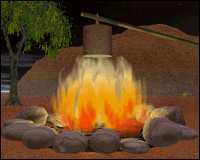Making Tea in the Australian Bush
Created | Updated Sep 3, 2014

Whether it is in the cold reaches of the tablelands, the hot flatness of the plains or the sticky humidity of the coastal forests (or anywhere in between for that matter), there is nothing that the sojourner therein could find more refreshing than tea brewed in the authentic way of the bush. Even if the party is there on bush business, brewing a cuppa adds a kind of picnic atmosphere to the occasion1.
Assuming that one has found an area of bush as yet untrampled and unpolluted (which will obviously later be left as close to that pristine condition as possible) one can then proceed to picnic. A tip: rather than keeping up a continuous 'bush salute' to wave away the sticky little bush flies, don't forget the insect repellent. A basic part of this picnicking is of course the actual brewing ritual. This is a highly satisfying, perhaps even exhilarating process, and there are many ways to go about it.
Why 'Billy'?
It seems originally that large 'bullybeef' cans were cleaned out after use and fitted with a wire handle and used as pots for the purpose of making tea. They eventually became known as 'billycans' part of the pioneering and swagman traditions. This practice may have begun during the gold rush era with the cans of beef imported from France. Later, the commercial can, available in various sizes, became more common, but if the purist wishes to construct his own, it is not difficult. If one goes this far, one should also make tin mugs from smaller containers, such as condensed milk tins. This could be seen as excessive, and can lead to burned fingers.
First Steps
Let us look only at the bare essentials of the process. Never mind the gentrified gas bottle and stove of the effete citified picnicker2. A true believer would not even take a shovel to dig a firepit, though after selecting a fairly clear patch where no grass or fallen material could catch to start a conflagration, you could choose to collect some rocks to form a containing circle3.
Fuel is important. First, there should be a sufficiency of dried grass or leaves collected for kindling, as the use of newspaper is frowned upon by purists, which is laid within the circle of stones, or piled evenly on the bare patch of ground.
Lighting Up
The next stage is to lay some small, dry twigs in a wigwam, and above them a similar layer of medium thick short pieces of dried wood.
Unless one has a Boy Scout whose legs may be rubbed together to start a flame, the use of matches to light the tinder is permissible. It is a sign of a good firelighter if only one match used.
Patience, now. Let the fuel be consumed gradually, adding longer, thicker pieces of branch till a good bed of coals is built up4.
Ensure that a green branch is at hand.
Boiling Up
Fill the billycan to about two-thirds full, as any more water will lead to it boiling over when the tea leaves are added. The best billycan is a blackened object, with or without a lid. With a lid, it does not get flakes of ash in it, but the disadvantage is that getting the lid off in order to drop in the tea leaves can be a tricky task unless the lid's handle is left in an already raised position.
Using the aforementioned piece of green wood, manoeuvre the billycan onto the fire, bumping it a little to seat it firmly. If the fire is well made, the water should not take long to boil, especially if a few more twigs are set around it.
It is at this point that the wonderful flavour of the tea is enhanced by judicious addition of some aromatic gumleaves to the flames5. The tea is best drunk black.
Brewing Up
Ebullition achieved, the tea leaves should be added to taste, given the shortest time to react, and then the can should be lifted very quickly from the fire with the green stick, doing one's best not to get the hairs on one's forearms singed, as this spoils the aroma.
After it is placed securely away from the fire, the side of the can is given a couple of smart raps with the stick, to settle the leaves.
True heroes of the bush may at this point grasp the (cooled) handle of the billycan and swing it, with a circular twist of a muscular wrist, round in a circle at right angles to the ground and above the head, so as to further infuse the tea.
No matter what it is now drunk from, whether it has milk and sugar added or not, there is absolutely nothing more satisfying than bush tea brewed in a billycan6.
The Last Step
And at the end, there is the satisfying hiss as the last of the tea and the leaves are used to douse the fire, a vitally important step, penultimate to cleaning up the firesite.

